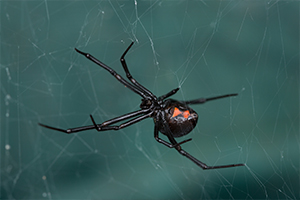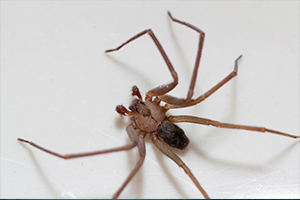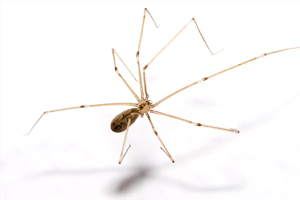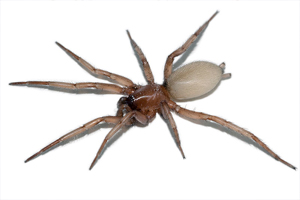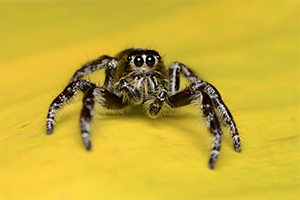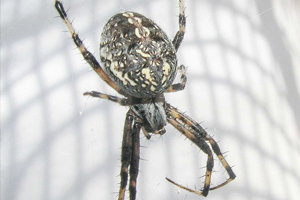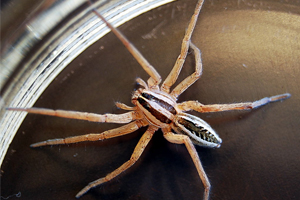Spiders
Spiders own their own phobia; and people with arachnophobia don’t consider any spider species itsy or bitsy, and we think these folks wished that rain would wash those spiders out–permanently! With thousands of species of spiders present in this country, only two are extremely dangerous to humans: the black widow and the brown recluse spiders (thankful we only have to worry about the black widow spider in California!). The spider has two body segments, the cephalothorax (head & thorax) and the abdomen. Spiders are beneficial for the control of insects but become a nuisance when they spin their webs on the outside of a structure or become an unwanted guest on the inside. Most spiders cannot penetrate the human skin with their bite and only bite after being provoked, or if they are trapped or crushed, like in a shoe. If a spider bite has been inflicted, capture the spider and take it with you to your physician for proper treatment. With so many species of spiders, these are the most commonly encountered:
Black Widow
This poisonous spider is the most commonly feared spider in the United States. The female is easy to identify with a large shiny black abdomen and red hourglass on the underside. Females are 1/2 inch or larger while males are about half that size. Males have white markings on the back of the abdomen and red markings underneath. The irregular shaped silk web is very strong and makes a popping sound if it is broken. The black widow catches insects in the web, wraps them in silk, and sucks the body juices from the prey. The saliva of the black widow dissolves the insect’s tissue so that it can be sucked out during the feeding. Woven silk sacks contain hundreds of eggs and are about a 1/2 inch in diameter. Widows are more likely to bite someone after they have laid their eggs and are hungry. After two to four weeks, the spiderlings emerge from the sack and spin silk strands to float away. After mating the female may eat the male but if the female is well fed, the male may be spared. If bitten by a black widow, see a physician immediately for treatment.
Brown Recluse
This spider is also known as the violin or fiddle back spider because of the dark brown violin on the cephalothorax. Many spiders appear similar in appearance, which requires identification by an expert. The brown recluse is usually found in the south to southeast states. Occasionally they have been found in other places due to being undiscovered during the shipping of boxes and packages. They prefer undisturbed locations such as: wood piles, utility boxes, debris, storage closets, attics, cracks and crevices. The bite is usually not felt because of the shy behavior of the spider and may turn into an open ulcer over the next couple weeks if not treated. Bites by other spiders, insects and wasps may resemble a brown recluse bite and can be misdiagnosed since the physician does not have the specimen to identify.
Cellar
This spider is known for its long legs, which can be up to two inches long. They will make their webs in barns, cellars, and eaves. The cellar spider hangs on its web with the abdomen facing upward. They will shake their web when disturbed. This spider is beneficial for the insects they feed on but is a nuisance because of the webs they create. This spider is often misidentified as the daddy long leg.
Ground Spider
The ground spider is an eight-legged arachnid with stripes across its body, and can be reddish, brown, black or grey in color. Most ground spiders don’t use webs to capture their prey – they crawl after their prey on the ground (hence their name!). They are not known to be super-venomous towards humans.
Jumping Spider
Jumping spiders, also known as Salticidae, also called Charlies, Salties or Herbies, actually do more of a dance than a jump, according to scientists. Plus, the name “Salticidae” is Latin for “dancing with pantomimic gestures.” These guys are active during the daytime, unlike most of its cousins, and they like to warm themselves in the sun. They’re usually black in color and have thick, short legs. Jumping spiders are known to have the best vision of any arachnid. They like to build their web retreats under furniture, in floor cracks and around windows and doors.
Orb-weavers
The orb-weavers will mature in the fall, which is when they are most noticed. The orb-weaver is known for its colorful markings and its elaborate web that it constructs. The orb-weaver is more beneficial than harmful and is normally found outside. Not typically a home invader and will commonly be found spinning its web between bushes and tree branches.
Parson
The parson spider will find its way into the house during the summer months. The body of the parson spider is 1/4 to 1/2-inch long. The abdomen is gray-brown with a whitish band around it. Parson spiders are hunters that do not spin webs but will establish a nest. Normally found outside in firewood or rock piles.
Tarantulas
The body of a tarantula is 3 1/2 inches with a span of 9 1/2 inches with the legs. Tarantulas have the capability of biting, yet they rarely do. They are sluggish and easily handled. During the early summer months, the male will seek out the female to mate. Tarantulas may live up to 20 years and have curious habits. They will generally create a burrow and live in the ground. They do not spin a web to catch prey but they will leave web lines that alert them of approaching prey.
Wolf
Wolf spiders are quite often confused with tarantulas, as they too are large, hairy spiders. Wolf spiders have eyes in three rows as opposed to normal spiders only having two rows of eyes. These spiders are hunters and do not construct webs to catch their prey. The body is 1 to 1-1/2 inches and has a leg span of 3 to 4 inches. They will generally create a burrow and live in the ground. They do not spin a web and hunt their prey.

